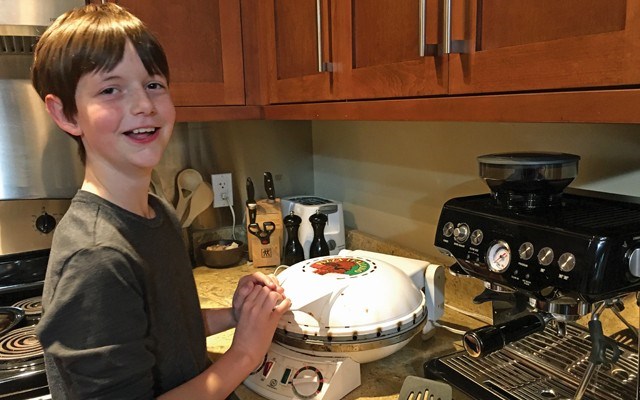Julia Child definitely had her views on kitchen tools.
"Oh Mary, I think everyone should have a blowtorch in the kitchen," she famously said to chef Mary Bergin on a Baking with Julia show. Mary was finishing a chocolate bundt cake with crème brûlée and Chambord raspberries by caramelizing the brûlée cream with a blowtorch.
"No, Julia," came the reply. "Every woman should have a blowtorch in the kitchen!"
I don't have a blowtorch in my kitchen, but I'm seriously thinking of getting one now. Actually, other than the basics, we don't use many appliances or special tools in our quest for "good eats" around here. Not that we're relegated to the minimalism of the sponges, sticks and stones that animals use for getting grub, as I described last week (go to www.piquenewsmagazine.com, Jan. 19 edition). But, really, in terms of kitchen utensils, we're pretty simple.
My goddaughter, on the other hand, is known for her kitchen tools, namely appliances.
If you lived in Squamish or went to school there mid-'80s to '95, you might know Aesha Faux, now a successful lawyer in Victoria and mom to Calum, 12, and Alistair, 10. In Aesha's kitchen today you'll find, among other appliances, a pizza maker; a slow cooker; two pasta makers, one for hollow pasta like penne and one for solid pasta; a waffle maker; a hand blender with various attachments; a hand mixer, again with different attachments; a blender; and a food processor. Aesh also used to own a panini press and a sandwich toaster, which turns regular sandwiches into something like calzones, but got rid of them because she didn't use them.
An anecdotal survey, yes, but an accurate one, I can assure you, with no "alternative facts," one that neatly demonstrates the breadth of popular kitchen tools available to just about anyone mucking about in a Canadian kitchen today.
Each one, when you think about it, is a marvel. Take the pizza maker. Resembling a mini-flying saucer, it holds a pizza stone upon which you place your fresh pizza dough, then the toppings. The lid holds a heating element. Both it and the stone heat to 450 degrees. Et voilà! In only 10 minutes you have a delicious pizza — raw dough included!
Tools like this can make our eating so effortless. But maybe not so easy.
In a department you'd think would be simple enough — forks — we humans have created, among others, the basic dinner fork, salad forks, tomato forks, snail forks, fish forks, fruit forks, dessert forks and deli or prosciutto forks. In all, quite the "forking" list. And that's not including serving forks such as the distinctive two-pronged roast fork, perfect for holding meat while you carve away.
Forks actually evolved from the knife, which, if you picture it, isn't far from the stick method chimps and carpenter finches use to get food. Yes, people used to eat just by stabbing things with their trusty knife or a nice long skewer, much like the ones used for kabobs. The earliest fork on record, Bee Wilson tells us in Consider the Fork, is a two-pronged gold one used by a Byzantine princess in 11th-century Venice.
Who remembers the Medieval Inn, a keystone of early Gastown in Vancouver? It hosted Whistler Question founders Paul and Jane Burrows' wedding banquet. I confess I worked there as a wench (not during the Burrows' feast, to be clear). In the spirit of medieval bacchanalia, guests were only given a knife to eat their entire meal. They loved it!
Over in the spoon department, and I'm not so sure this means we are that much more evolved than birds and ants, we have the basic spoon; the marrow spoon for digging out bone marrow; the coffee spoon; the demitasse (smaller than a teaspoon); the caviar spoon (mustn't be made of silver to avoid impacting the taste), and the bouillon spoon, smaller than the soup spoon which, says Wilson, actually fell out of fashion for a while in the early 19th century when using a fork to eat soup was favoured! (That didn't last long.)
Quoting food writer Dara Goldstein in her 2006 Feeding Desire: Design and the Tools of the Table, Wilson describes "fork anxiety," which occurs when you're at a "grand dinner" and confronted with too many kinds of silverware for common sense to contend with.
"There probably never was a time when all of these forks were in use, but you can see how the very existence of a tomato fork could generate anxiety," notes Goldstein. Indeed.
And I haven't even mentioned the knife, which I'm sure someone somewhere is writing an entire book about.
In fact, it was a search for the perfect knife that galvanized the friendship between the late, great Julia and Avis DeVoto, who was instrumental in getting published the first volume of Julia's seminal masterpiece, Mastering the Art of French Cooking. Avis, notes editor Joan Reardon in As Always, Julia, was married to historian and journalist, Bernard DeVoto, who caught Julia's eye with his 1951 article in Harper's Magazine on getting the average American housewife a perfect kitchen knife. I'll probably get myself blacklisted for saying this, but American-made stainless steel knives couldn't hold an edge, so the quest was on for a decent carbon steel paring knife.
Julia Child and the DeVotos eventually found a decent knife. But, as we all know, having the perfect tool in the kitchen doesn't necessarily lead to the things we love. Just ask Aesha. With all those appliances, what are her boys' favourites these days?
"Lettuce wraps and burritos!" she says with a laugh. Ah, yes, tube food in edible wrappers — now there's another topic worth exploring.
Glenda Bartosh is an award-winning journalist who still uses a 1970s toaster oven.




